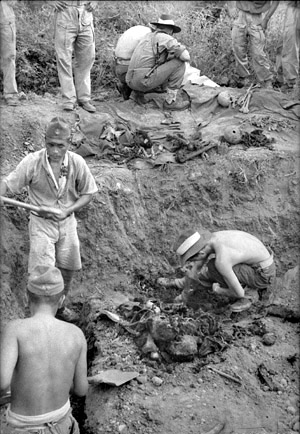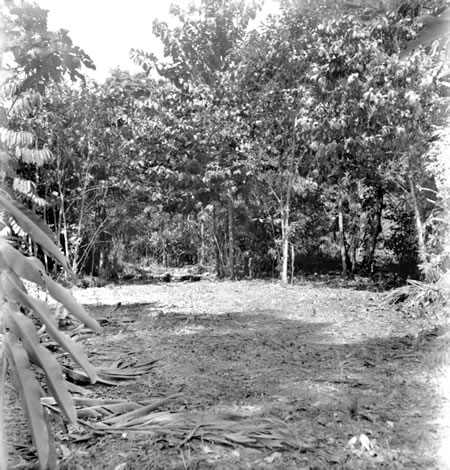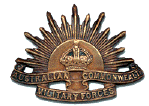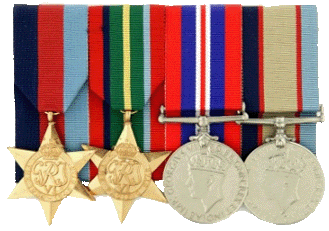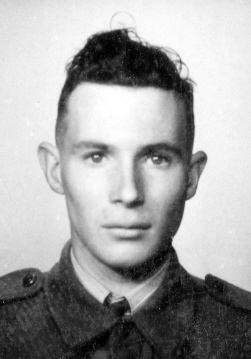EXECUTIONS OF AUSTRALIAN AND DUTCH PRISONERS
LAHA AIRFIELD - AMBON ISLAND
Considerable time has been consumed in tracking down witnesses who clearly were deliberately evading apprehension 1) Reinte. Because of the nature of this atrocity and their probable Malay involvement. Of four witnesses (suspects) arrested, two are unhelpful and hostile.
File 85H. 851, 85K EXECUTIONS OF AUSTRALIAN AND DUTCH POWs, LAHA AIRFIELD, AMBON ISLAND,
1) 4 February 1942 I Re-interrogated former civilian interpreter (Dutch and Malay language) Saburo Yoshizaki of Kure No.I SNLP. Yoshizaki was stationed at Laha Airfield from the morning of 3 February, until the morning of 10 February 1942. In regard to the first executions at Laha Airfield (9 February 1942), Yoshizaki admitted he, another civilian interpreter by the name of Terada Okada, and Ist Class P0 Tasuki Yamashita 1st Class visited the scene of the execution on their own accord, the time of their arrival there being about I800 hours.
According to Yoshizaki there were two prepared graves (holes - 'A' and 'B' ) both circular in shape and of similar dimensions, namely six metres in diameter and about three metres deep.Grouped around the sides of each grave were one or two officers and about twenty odd marines and soldiers including petty officers and NCOs.
He states that just prior to the commencement of the executions, a marine (rank and name unknown) came over to where he and some companions were standing and requested the loan of his sword. Yoshizaki states he loaned his sword to the marine whereupon the latter disappeared among a group of marines standing about hole 'B'. Yoshizaki then described the execution of the first Australian prisoner at grave 'A'; this decapitation being carried out by Warrant Officer Kakutaro Sasaki. He recalls that after the fourth prisoner had been beheaded by individual marines keenly waiting their turn (ranks and names unknown) at grave 'A', several battery torches were procured to light the backs of the necks of each successive victim. After the seventh or eighth Australian had been decapitated at grave 'A'. the marine who had borrowed the sword, returned it to Yoshizaki commenting that it was blunt and the blade had unaccountably bent when he had beheaded a giant of a fellow.
On receipt of his sword and scabbard. Yoshizaki stated he and his companions departed the scene of the killings and returned to their barracks. Yoshizaki denied having witnessed the executions of prisoners at grave 'B' as his attention was concentrated on the macabre drama at grave 'A'. Yoshizaki claims that he learned later that in addition to Dutch mortar unit personnel (about thirty prisoners). Fifty-five Australian soldiers had also been beheaded on the night in question.
2) Concerning the second executions. Yoshizaki states that on his return to Ambon township on 23 February 1942 (he had been absent on interpreting duties at Paso) he heard from, he believes, Ist Class Petty Officer Tasuki Yamashita that between 15-20th February 1942 (exact date not recalled) all the remaining prisoners ( Australian) at Laha Airfield had been decapitated, some eighty odd as related to him by Yamashita. Yoshizaki avers that he was told that this second execution at Laha had been carried out by crew members of a Japanese minesweeper that had been sunk previously by an enemy mine in Ambon Bay. It was an act of reprisal and retaliation for the loss of their ship.
(3 ) Re-interrogated former 1st Class Seaman Miyataro Ichio who has been identified as having been present and to have participated in the mass execution of Dutch and Australian prisoners at Soeakodo in early February 1942 He denied having been present at these executions. Claiming to having been suffering from recurring malaria indisposition, at that particular time and all efforts to budge him from this dubious explanation proved futile.. He was certain that his former officer commanding, Warrant Officer Kyusuke Yamashita, had named him as being one of the dozen or so marines present at the said executions as he. Ichio, thought that the latter believed him dead and as such would not inconvenience other members of his platoon who did participate.
Investigating Officer
2nd Australian War Crimes Section
16th December 1949
OBSERVATION
This deception has endured for well over four years. To launch a full investigation and obtain evidence ( the prisoners remains) is a daunting but necessary task. It could take months
With no guarantee of success, Major MacKay opinions, upon General Willoughby learning of this atrocity he could well prohibit any further investigation on the grounds that with Japanese/ American reconciliation it is no longer the time to revive or exacerbate public feeling on such evil.
File 85 H. 851 Execution of Australian and Dutch P0Ws. Laha Airfield Ambon 1942 Continuation of investigating a second massacre
I have completed the interrogation of former Warrant Officer Keigo Kanamioto, the Officer Commanding (L) Repair and Construction Unit of Kure No. I. SNLP Special Navy landing party. Kanamoto was the O C during February 1942. Kanamoto states that on or about 20 February 1942 and while stationed at the captured Victoria Barracks at Ambon. He learned From a fellow officer that a further 220 prisoners would be executed 1800 hours that evening. Only he, Kanamoto, was wearing a samurai sword. He recalls that 1st Class Seaman Shikao Nakamura and lst class Seaman Teruji Ikezawa were two of the volunteers who accompanied him.
According to Kamamoto he and his said three companions did not arrive at the scene of the executions until about 1900 hrs by which time it was almost dark. Several bonfires had been lit and cast dancing shadows on a spectacle reminiscent from the pits of Hell. A large group of Dutch and Australian prisoners of war, all with their arms and hands securely bound behind them and heavily guarded stood waiting in the shadows to be executed.
The punishment site was situated in the same wooded area where the first mass execution of POW s at Laha had been earlier carried out. Kanamoto states that there were two large holes of similar dimension and situated about five metres apart, hereinafter referred to as grave 'A' and grave 'B'.
Grave 'A' was encircled by about thirty marines many of whom were carrying borrowed swords. Among them Kanamoto perceived one officer and a couple of NCOs whose names he could not recall. He was able to state positively that no soldiers or marines stood around grave 'B'.
Kanamoto then provided a harrowing description of what followed. He recalls witnessing the beheading of a young prisoner who shouted desperately and despairingly before being decapitated on the nearest side of grave 'A', followed seconds later by the beheading of another prisoner on the opposite side of the said grave. The flickering light from nearby bonfires was insufficient to properly illuminate the carrying out of the punishments (executions), consequently battery torches were produced and used to light the necks of each victim.
After about twenty decapitations, curiosity impelled Kanamoto to step forward and peer into grave 'A'. Some corpses were headless but several bodies with heads half-attached were .jerking feebly and making faint gurgling moans. Kanamoto avers that a feeling of revulsion mixed with pity swept over him, but he could not interfere in the punishments that had been ordered by the Japanese High Command in the area.
A little time later and with about forty executions carried out, subordinate 1st Class Seaman Nakamura borrowed Kanamoto's sword following which he beheaded four Dutch in quick succession on the nearest side of grave 'A' . A short time later 1st Class Seaman Ikezawa took Kanamoto's sword and similarly beheaded three more prisoners, this time Australians. According to Kanamoto, Ikezawa then passed his sword to another subordinate (name not recalled) to behead more prisoners on the far side of grave 'A'.
Two further decapitations were successful, but the third attempt required two sword strokes, a strange sound and sparks concluded the sword's use. Kanamoto claims that he then recovered his sword which, upon inspection by torchlight, was found to be nicked at several places and slightly bent.
After watching a dozen more beheadings and feeling somewhat uncomfortable witnessing such mass butchery, Kanamoto avers that the constant shouts of jubilation from watching marines mixed with ribald scorn as some prisoners begged for their lives. became too much for him. He and his subordinates made their way to the garrison office (Laha Airfield) where he met Warrant Officer Rinnosuke Fukuda who was the relieving OC of the garrison unit of Kure No. 1, SNLP that was stationed at Laha at that particular time.
Kanamoto avers that he admitted, when asked by W.O. Fukada if he had beheaded any of the POWs, that he had. Conversely and to this investigating officer, Kanamoto pleaded that this false admission to Fukada was to avoid losing face in front of the latter. Kanamoto then stated that he and his subordinates returned to the Victoria Barracks at Ambon by launch at about 2230 hours.
During luncheon the following day, Kanamoto heard that all the POWs (amended to 227) had been punished (executed) and that the incident was not completed until 0130 hours in the ensuing morning. He admitted, to avoid confusion, that though the two massacres paralleled each other at Laha Airfield, the dates were different and so far as the second massacre was concerned, the number of prisoners executed were far greater. Kanamoto was unable to provide the names of any of the executioners (there were so many of them), except those of his two subordinates. However, he did know that the crew of a destroyed Japanese minesweeper (No. 9) were responsible for slaughtering the majority of the Australian and Dutch POWs as an act of vengeance.
Kanamoto strongly denied the adverse allegations made against him by other surviving members of Kure No.I , SNLP and contributed such mendacity to their malevolent spite because it was known by them that he had broken the code of silence about the incidents. It is accepted by this investigating officer that Kanamoto is no doubt genuinely correct in his assertion, but the opinion is also held that Kanamoto may be deceitful in his denials of having taken no part in the beheading of prisoners which, by no stretch of the imagination, should be described as punishments or incidents. It is also noted that Kanamoto answered most questions in a pariphrastic and circumbagious manner. This investigating Officer appends his name to this report for the final time and for reasons known to -
Lt Colonel DLB Goslett,.
Major Williams
and Legal Officer Major A D MacKay.
Quod Erat Demonstradum Captain J G Godwin
A working party of Japanese POWs excavates
Australian and Dutch remains from a mass grave
at Tawiri, Ambon, under the direction of the
Australian War Graves Maintenance Unit,
December 1945.




